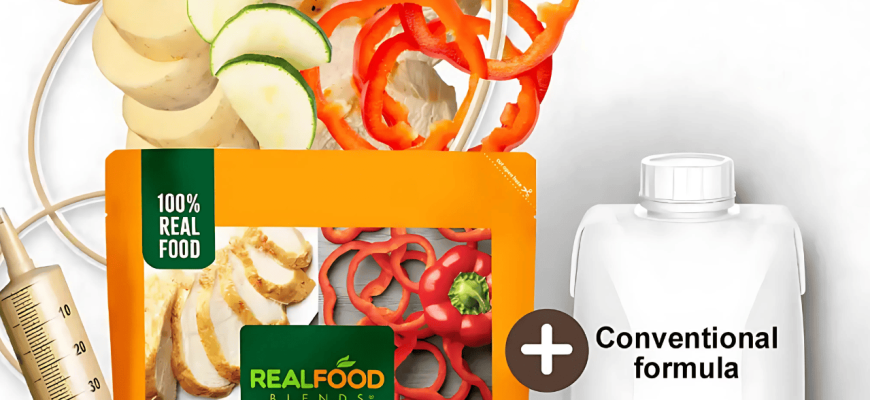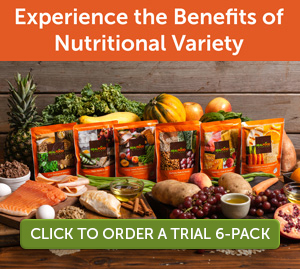
In clinical practice, we are trained to look for clear answers.
We rely on structured plans and defined protocols, and for good reasons: that kind of clarity helps reduce risk and guides decision-making in complex cases. But not everything in care works best when it’s black and white. Nutrition, especially, often falls somewhere in the gray.
People eat differently day to day. Their needs shift with age, illness, appetite, or circumstance. And what works for one person or family may not work for another. So, when we bring rigid thinking into tube feeding, whether it’s expecting either all formula or all homemade meals, or assuming that every meal must be perfectly calculated, we forget that tube-fed individuals are people too.
Their nutrition deserves the same flexibility and personalization we give everyone else. It’s time to expand how we think about enteral nutrition.
Making Room for Flexibility in Tube Feeding
The reality is that most people who eat by mouth do not eat the same thing every day, or prepare every meal from scratch.
People eat to fuel up for a big event, because something smells good, to connect with others, or just because it’s lunchtime. Meals are often a mix of home-cooked food, takeout, convenience options, frozen meals, and snacks. Many of these choices are spontaneous and do not require strict calorie or nutrient tracking, and nobody expects that.
People using feeding tubes are living life, too. Yet, tube-fed individuals and their families are often made to feel like they must be very rigid, tracking every nutrient and making every meal perfectly balanced to succeed. It is no surprise that this pressure leaves many feeling overwhelmed, boxed in, and stuck. The truth is, we have made this harder than it needs to be.
By not recognizing the real-life needs and limits of families, many end up with feeding plans that do not feel good and miss out on the health benefits of including real food in a manageable way – benefits that everyone else is encouraged to enjoy.
Clinical Benefits of Real Food for Tube Feeders
There is growing evidence that real food can make a noticeable difference for people receiving nutrition through a feeding tube. Across multiple studies, families report fewer symptoms like nausea, vomiting, abdominal pain, diarrhea, and reflux when switching from conventional formula to a blenderized diet1.
We are still learning exactly why this happens, but there are a few likely reasons:
- For one, real food is often thicker than standard formula, which may help reduce reflux and vomiting2.
- A blenderized diet tends to provide an improved nutrient profile comprised of diverse whole food ingredients, which exert a more physiologic gastric motility profile2.
Research also shows that growth can continue as expected on a blended diet. In fact, one study observed improved weight and height z-scores after children transitioned to real food3.
And those are just the physical outcomes.
People who use a blenderized diet, and the caregivers supporting them, report feeling more satisfied with feeding compared to those using conventional formula.
Many say it feels more personal and empowering. It allows families to share meals, prepare food together, and feel more connected4.
Real-life success stories reflect these experiences, showing how real food can bring meaningful changes beyond just nutrition.
Why Variety Matters in Blenderized Food and Formula
I’ve seen firsthand just how important variety is when it comes to how well someone tolerates their tube feeds. Most people on tube feeding end up getting the same formula for every meal, every day. I understand that this approach can be easier for clinicians to manage and for insurance to approve. It simplifies things and makes the feeding plan easier to follow, at least on paper.
The same thing happens with home blends. Families often receive just one recipe or a template to follow. Without much guidance or support, it’s easy to get stuck making the same blend day after day. And even when that recipe uses healthy whole foods and meets nutrient needs, digestive issues can still linger.
Think of it this way: If you had to drink the same nutrition shake for every meal, even if it met all your needs, how would you feel? You might feel sluggish. You might notice changes in digestion or energy. Our bodies are built for variety. Different foods support different gut bacteria, digestion, and overall wellbeing.
So, when we move away from all-or-nothing thinking, it becomes much easier for families to rotate foods, experiment, and find what works best, without burning out.
And that flexibility matters.
The Role of Commercial Blenderized Formulas in Simplifying Blended Diets
This is why I really appreciate having options that make it easier for families to include real food without adding extra stress.
Commercial blenderized formulas provide a way to stay connected to real food and all its benefits, even when life gets busy or unpredictable. Real Food Blends® is a commercial blended option made from 100% real food and is the closest to homemade blenderized tube feeding, compared to other blenderized enteral formulas.
They make it simpler to get started, offer a reliable backup on hectic days, and help families stay consistent with their goals without needing to blend every single meal from scratch. It’s also important to mention that I’ve worked with hundreds of families whose children struggled to tolerate formula alone, even when it was made from real food. But when those products were combined with home blended meals, tolerance improved, feeding became more manageable, and families felt a lot more confident in their approach.
So, if you’re working with families who are struggling, you might be surprised at how much smoother things can go when they don’t have to pick between all formula or blending all their food.
Supporting Blended Diets in Clinical Practice
I understand that it can feel uncomfortable not knowing exactly what is in a homemade blended meal. You might worry about whether the calories are right, if the nutrients are balanced, or how to document it in the chart. Those are valid concerns.
But there are ways to start slow, safely, and with structure:
- Start with one meal.Help the family choose one feeding to blend and build a meal that matches the calories of their typical formula feed. Just replace one meal for a while and use this as a chance to learn with them!
- Use recipes with known calorie concentrations.Home blend recipes for tube feeding that range from 1.0-1.5 calorie per mL, like many formulas, make it easy to swap 1:1 and maintain consistency.
- Look at the big picture.Monitor growth, periodically assess intake and look for nutrient gaps, consider medical conditions and medications, and get lab work as needed – just like you would for someone eating by mouth. Add vitamin and mineral supplementation as needed.
We also need to recognize that the expectations we place on tube-fed individuals are often unrealistic. We rarely know exactly what oral eaters consume each day, and we do not expect that level of precision from them.
We don’t tell children or adults to drink only packaged nutrition shakes just because we can track those more easily. Tube-fed children deserve the same trust and flexibility, along with the support to make real food work for them.
A Balanced Approach to Real Food and Tube Feeding
Supporting real food doesn’t have to be complicated, and it doesn’t have to be all or nothing.
As clinicians, we can play a powerful role in helping families feel confident and supported as they figure out what works. And it’s okay if it looks different for everyone. For some families, that might look like one home blended meal a day. For others, it might mean making most of their food and only supplementing with a commercial real food product on occasion. And for most families, it means adapting to what works best for them in the moment, because every day and every week can look different.
The point is, there are options, and real food can fit into a tube feeding plan in more than one way. When we let go of the idea that there’s only one “right” approach, it gives families a real chance to try.
And when they do, it’s not just digestion that improves. Tube feeding becomes more manageable, more personal, and a lot less stressful.
Hilarie Geurink is a consultant for Nutricia North America and has been compensated to write this blog post.
References:
- Hron B, Fishman E, Lurie M, et al. Health Outcomes and Quality of Life Indices of Children Receiving Blenderized Feeds via Enteral Tube. J Pediatr. 2019 Aug;211:139-145.
- Walker S, Johnson T, Carter H, et al. Blenderized food tube feeding in very young pediatric patients with special healthcare needs. Nutr Clin Pract. 2023;1-8.
- Batsis ID, Davis L, Prichett L, et al. Efficacy and Tolerance of Blended Diets in Children Receiving Gastrostomy Feeds. Nutr Clin Pract. 2020 Apr;35(2):282-288.
- Bennett K, Hjelmgren B, Piazza J. Blenderized Tube Feeding: Health Outcomes and Review of Homemade and Commercially Prepared Products. Nutr Clin Pract. 2020 June;35(3):417-431.
Comments are closed.






